13 Safe Exercises For Osteoporosis With Steps And Pictures
Strengthen and protect your bones today for a better and happier tomorrow.
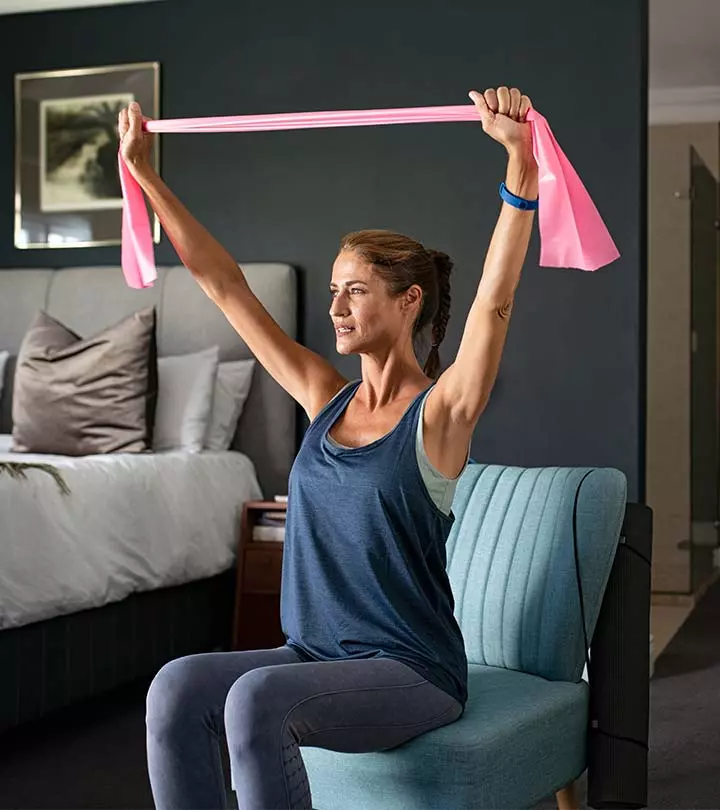
Image: Shutterstock
Exercises for osteoporosis are an effective strategy to increase bone density and minimize fractures. The International Osteoporosis Foundation deems osteoporosis (loss of bone mineral density) as a silent disease (1). Unless you get a fracture, you will not know that you have osteoporosis. Dr. Siddharth Tambar (MD, Rheumatology and Regenerative Medicine) says, “Women are especially susceptible to osteoporosis after menopausei The natural end of a woman's menstrual cycle, happening around the age of 50, which signifies the end of fertility. .”
According to the National Health and Nutrition Examination Survey conducted between 2017–2018, the prevalence of osteoporosis among US adults aged 50 or above was 12.6%. Furthermore, the percentage of women (19.6%) affected by osteoporosis was more than men (4.4%).
UK-based sports nutritionist Zaakir Kayani (PG Diploma in Sports Nutrition with the International Olympic Committee) emphasizes the importance of exercising: “Regular exercise is a great way to build strong bones and slow down bone loss. Starting out from an early age and maintaining exercise throughout life is highly recommended.”
Research led by New York-based Dr. Loren Fishman (MD) proves that regular yoga can help strengthen bones and help improve bone mineral density (2). Dr. Fishman points out, “Older adults with mobility problems can benefit hugely because yoga not only strengthens their bones but also makes their whole bodies stronger, produces better balance and straighter posture to prevent falls, and improves mood and confidence.”
Check out the 13 safe osteoporosis exercises described with pictures below. Doing these low-impact, no-impact, and weight-bearing exercises for 10-15 minutes daily can potentially reverse and prevent osteoporosis. Read the guidelines recommended by experts and the benefits of osteoporosis exercises too. Scroll down!
 Workout Blueprint: Exercises For Osteoporosis
Workout Blueprint: Exercises For Osteoporosis- Frequency: 3-5 times per week
- Benefits: Increase bone density and improve muscle strength and balance.
- Equipment Needed: Chair, resistance band, rolled towel.
- Space Required: Small area
- Assistance Required: Yes
- Who Should Avoid: Individuals with recent fractures or mobility issues.
In This Article
Basic Guidelines Of Osteoporosis Exercises
- Warm-up before exercising.
- Use a hot pack or take a shower with hot water before exercising if you have limited mobility.
- Consult your doctor before doing these exercises.
- Do these exercises under the supervision of a certified fitness trainer.
- Focus on form.
- Do these exercises on the bed or a chair if you are unable to stand up.
- Do standing exercises near a wall or take the support of sturdy furniture.
- Place a 10-15 mm yoga mat to reduce the impact in case of a fall.
- Increase sets and reps gradually.
- Try weight-bearing exercises for osteoporosis only if you are comfortable.
- Stop any movement if you feel a sharp pain.
- Take rest to help your muscles and bones rejuvenate.
- Also, try doing resistance band training.
Follow these basic guidelines to prevent aggravating a pre-existing pain or for fall prevention and fracture prevention. Scroll down to know the 13 best osteoporosis exercises that work well.
Experts believe that exercising is crucial for people with osteoporosis and its prevention. Scroll down to know the 13 best osteoporosis exercises that work well.
Key Takeaways
- The goal of osteoporosis exercises is to strengthen your bones and muscles, which results in better posture and balance.
- The prevention and treatment of osteoporosis begin with exercises such as chair squats, trunk rotations, and resistance band bicep curls.
- You must avoid high-impact exercises like rope jumping, sprinting, and weightlifting if you have osteoporosis.
13 Best Osteoporosis Exercises And Yoga (Steps And Pictures)
, Osteoporosis and Cancer Exercise Specialist, says, “An effective exercise program includes aerobic (weight-bearing), strength training, and posture and balance exercises. It is important to focus on exercises designed to treat osteoporosis by strengthening the bones and muscles, leading to better posture and balance. Strength training actually stimulates the bone because the muscle is pulling on the bone. We lose muscle mass as we age, and with less muscle, there is less tugging on the bones. So, not only does strength training increase our muscle mass, which has numerous benefits, but also stimulates the bones. Exercising while standing is more effective and can help with balance as well.”
With that in mind, here’s your osteoporosis exercise plan:
1. Chair Squats
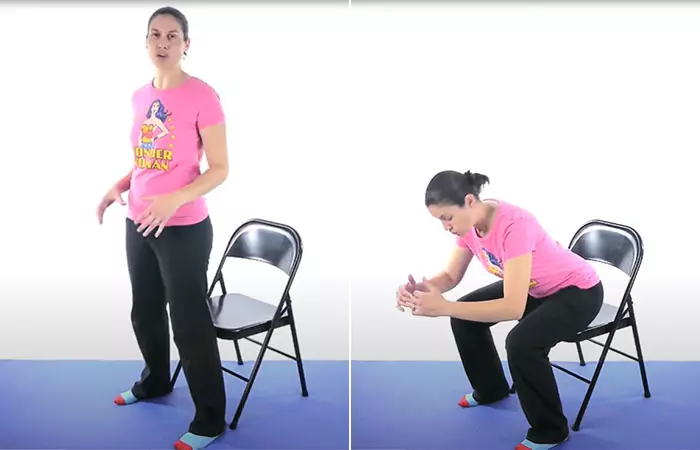
This is a great full-body strengthening and balancing exercise. It can be done as a chair exercise for seniors as well. A chair with an armrest is preferred so that you can rest your fingertips on it for support. You can also do this exercise on a sofa.
Steps
- Stand with your feet wider than shoulder-width apart in front of a chair. Roll your shoulders back, elongate your spine, and look forward.
- Push your hips back, flex your knees, and lower your body.
- Tap on the chair and stand back up to the starting position.
- Do this 10 times and increase the reps and sets.
Note: Avoid doing this exercise if you have knee arthritis, lower back pain, or a knee injury.
2. Chair Calf Raises
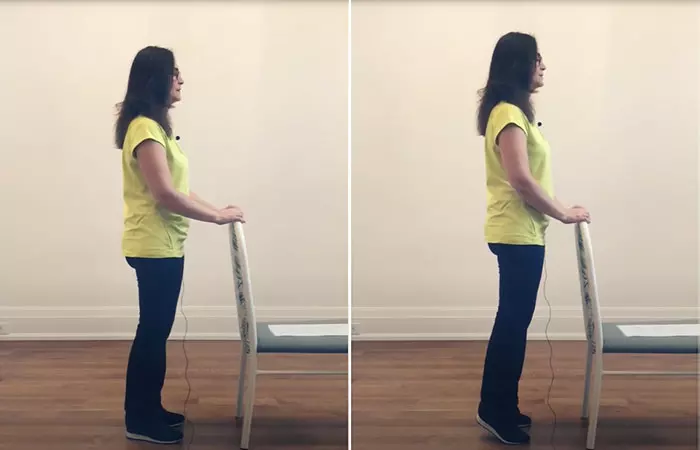
These work on the calf muscles and help strengthen them.
Steps
- Stand behind a chair and place your hands on the backrest. Roll your shoulders back and look forward. This is the starting position.
- Raise your heels off the ground.
- Pause for 5-8 seconds, exhale, and place your heels on the ground.
- Do this 15 times.
3. Hamstring Curl With Balance Improvement
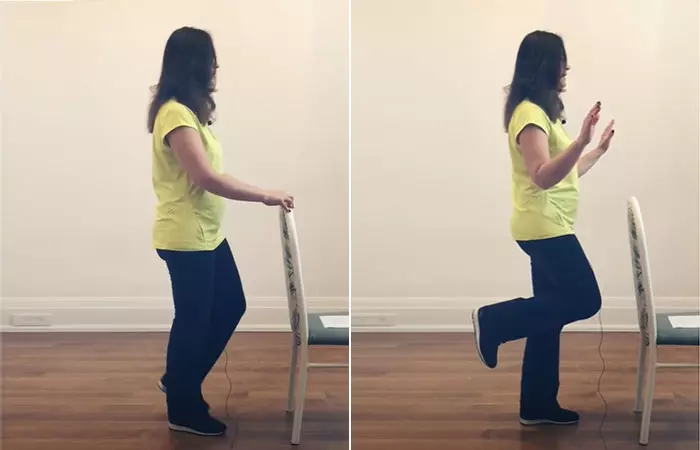
Hamstring curls strengthen the hamstrings, quads, and knees. They improve the balance of the body and enhance mobility. Support your hands on the backrest when doing this thigh and knee-strengthening exercise for a few days or weeks. Once you are comfortable with the exercise, take your hands off the backrest to improve your balance.
Steps:
- Stand behind a chair and place your hands on the backrest.
- Lift your right leg off the floor, flex your knee, and curl your shin up.
- Pause for a moment and place your right foot back on the floor.
- Do the same with the left leg.
- Do this 15 times.
4. Leg Swings Balance Exercise
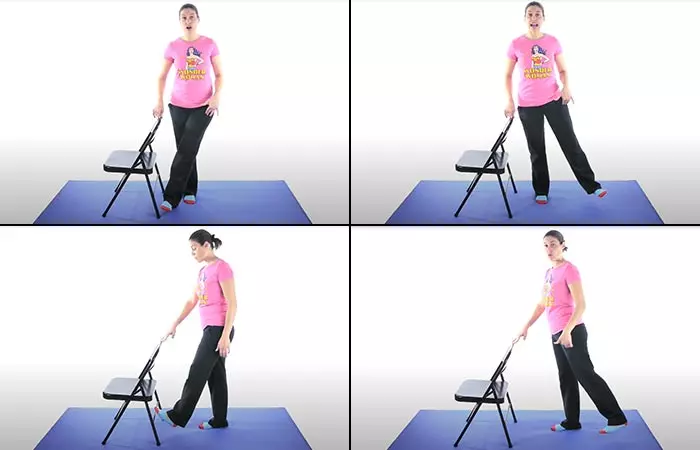
This is another balance-improving exercise that is helpful for people with osteoporosis and those who want to prevent its risk. You need a chair for this exercise for support.
Steps
- Place a chair to your right and hold the backrest with your right hand. Stand with your feet hip-width apart and roll your shoulders back.
- Lift your left foot off the floor and take it laterally out. Keep your toes pointing forward.
- Swing your leg back and bring it across the front of the right leg.
- Repeat 10 times and do the same with the right leg.
- Stand behind the chair. Place one or both hands on the backrest.
- Lift your right leg off the floor and swing it back and forth.
- Repeat 10 times and do the same with your left leg.
5. Resistance Band Bicep Curl
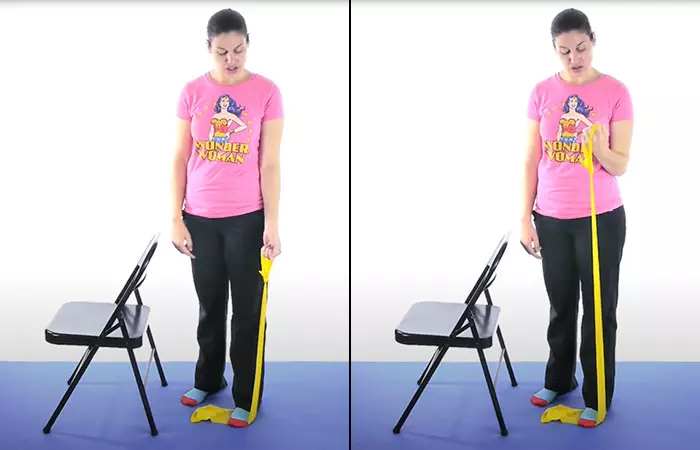
The bones in your hands also become weaker with age, especially the wrists. Doing weighted osteoporosis exercises, such as using a resistance band, helps improve muscle strength and flexibility in your hands, thereby improving bone health. You need a flat, open-ended therapy band.
Steps
- Step on one end of the resistance band with your right foot.
- Hold the other end with your right hand with the arms fully extended.
- Curl up your hand, keeping your elbow pressed against your body.
- Bring your hand back to the starting position.
- Do this 10 times before switching hands.
6. Lying Leg Drops
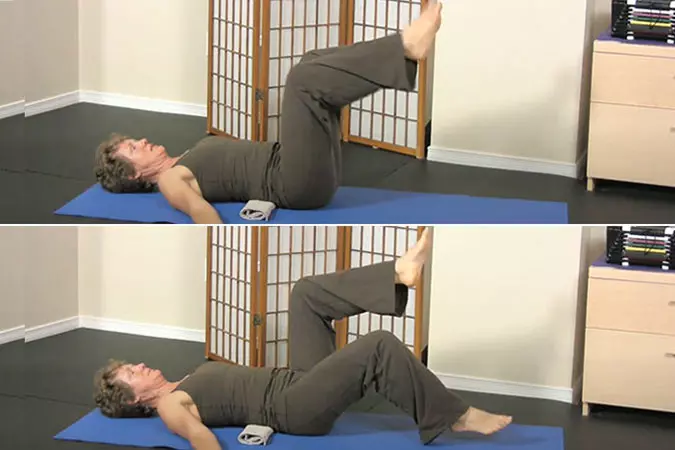
This is a low-impact core-strengthening exercise for people with osteoporosis. You need a rolled towel to support your lower back.
Steps
- Place a rolled towel on a mat.
- Lie down on the mat carefully. Adjust the rolled towel so that it is placed right where your lower back curves.
- Lift both your legs off the floor, and keep your knees flexed so that your legs are at 90 degrees. This is the starting position.
- Bring your right leg down.
- Tap the floor and lift your right leg back to the starting position.
- Do the same with your left leg to complete one rep.
- Do this 15 times.
7. Trunk Rotation
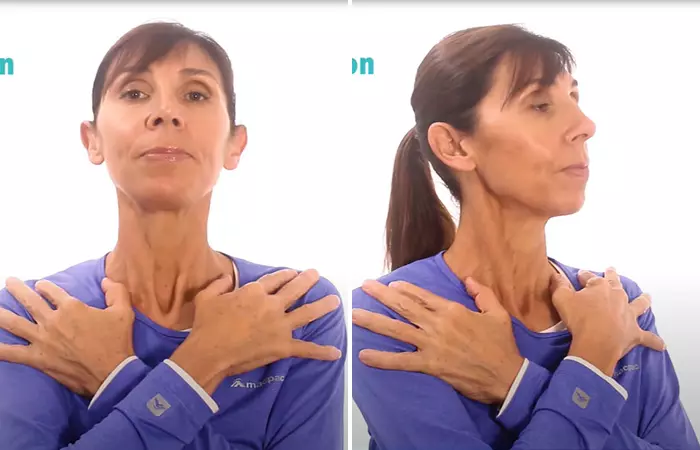
This is a no-impact exercise that strengthens the spine.
Steps
- Stand with your feet hip-width apart.
- Place your arms across your chest as shown in the image.
- Roll your shoulders back and look ahead. This is the starting position.
- Twist your upper body to the left and right.
- Do this 15 times.
8. Core-Strengthening Exercise

Once you are comfortable with leg drops, try doing weighted exercises to strengthen your spine. You need a thin, open-ended resistance band for this exercise.
Steps
- Hold a resistance band and gently lie down on a mat.
- Wrap the band around your feet. Hold on to the end of the band and keep your legs extended and perpendicular to the floor. This is the starting position.
- Flex your knees and bring them close to the chest.
- Push your legs back up to the starting position.
- Do this 10-15 times.
9. Arm Front Raise & Step Back
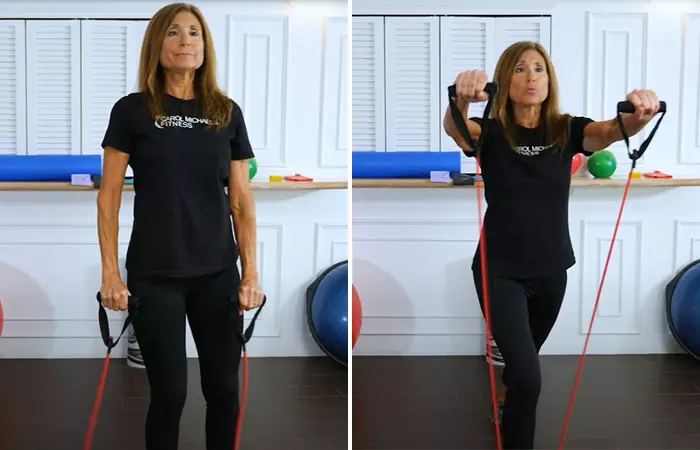
This is a good muscle-strengthening and balance exercise. You need a rope-like resistance band or a flat therapy band for this moderate-impact weighted osteoporosis exercise.
Steps
- Step on the resistance band with your right foot. Keep your left foot slightly behind the right. Hold the handles or ends of the band.
- Raise the arms until the band reaches shoulder level.
- Simultaneously, take one step behind with your left foot.
- Hold it for 3-5 seconds, lower your arms, and bring your left foot back to the starting position.
10. Chest Opener
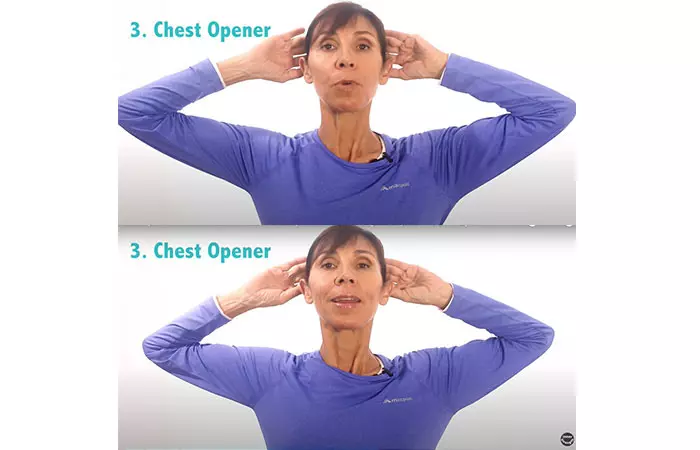
This is a no-impact osteoporosis exercise that you can do either standing up or sitting down. It strengthens the shoulder and the chest muscles.
Steps
- Place your hands behind your head. If that is painful, you can place your right and left hands on the respective shoulders. Keep your elbows out.
- Inhale and stretch your elbows by squeezing your shoulder blades together. Hold for five seconds.
- Come back to the starting position. Exhale.
- Do this 15 times.
11. Spine Strengthening Exercise
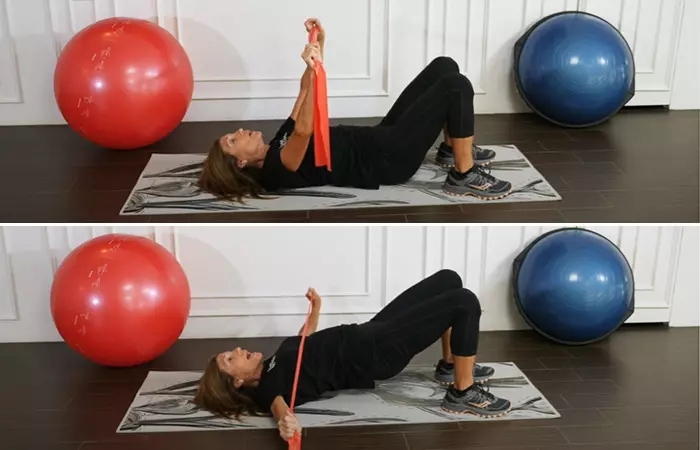
This is a bridge exercise combined with chest openers with a resistance band. It helps strengthen the spine and glutes and improves spinal stability. It is also a great core exercise for seniors and adults alike.
Steps
- Lie down on a mat and hold a therapy band. Keep your hands shoulder-width apart and feet flat on the floor, about 2 feet away from your hips.
- Push your hips up toward the ceiling and squeeze your glute muscles.
- Move your hands apart simultaneously until the hands are almost touching the floor.
- Pause for a moment, lower your hips, and bring your hands back to the starting position.
- Do this 10 times.
12. Hip Strengthening Exercise

This exercise helps reduce the risk of hip osteoporosis and hip fractures. You need a loop resistance band to do it.
Steps
- Sit on a mat. Wrap a loop resistance band right above the knee.
- Lie down on the right side, support your head with your right hand, and place the left on the mat.
- Keep your thighs at 90 degrees with the shin as shown in the picture.
- Lift your right leg towards the ceiling. Do not extend it.
- Bring it down.
- Do this 10 times before switching sides.
13. Bridges
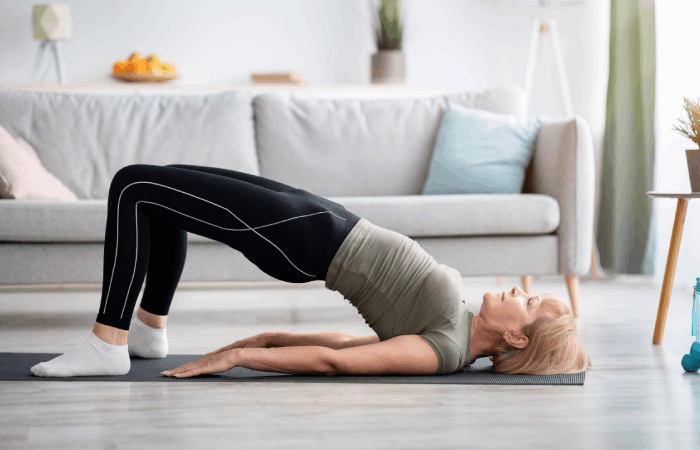
Steps
- Lie on your back on a comfortable surface or on a yoga mat.
- Bend your knees and place your feet flat on the floor, hip-width apart, and your arms at the sides.
- Inhale and engage your core muscles.
- Press through your heels and squeeze your glutes as you lift your hips towards the ceiling.
- Form a straight line from your shoulders to your knees at the top of the bridge position.
- Hold the bridge position for a couple of seconds as you keep your core muscles engaged.
- Exhale as you gently lower your hips back down to the starting position.
- Do this for 2–3 sets of 10–15 repetitions each.
These are the 13 exercises you can do for treating osteoporosis. But do these give results at all? Let’s find out in the following section.
Why Exercising Is Good For Osteoporosis?
says, “For all osteoporosis patients, exercise is an important intervention.” He emphasizes starting early on to prevent the risk of osteoporosis. He says, “Exercise is a primary preventive means of reducing the risk for osteoporosis. However, the effects of exercise on individuals are variable. Younger individuals have a higher response in terms of an increase in bone mass. In older individuals, it may be more about the maintenance of bone and muscle integrity. So, we should encourage our 30 – 40 year olds to exercise more regularly as a long-term preventive strategy.”
Dr. Loren Fishman, MD, Medical Director of Manhattan Physical Medicine and Rehabilitation in New York City, says, “Yoga can prevent and reverse bone loss by building the bone.”
 Quick Tip
Quick TipExercising not only improves bone strength but also boosts balance, flexibility, mobility, and self-confidence. But is there a limit to doing these exercises? How much exercise is too much? Let’s find out below.
How Much To Exercise For Maximum Benefits
It is best to start with 8-10 reps per exercise and move on to more reps and sets in a week’s time. According to Dr. Tambar, “A high exercise frequency may contribute to injuries. I would recommend starting at 3 times a week and increasing it to 5 times a week. Give your body plenty of time to rest between exercise days if it is prone to injuries. Start at lower loads initially when coming back from injury.”
Talk to your doctor and a licensed physical therapist to know what your physical therapy and frequency of exercise, sets, and reps should be. However, you have to be extra careful if you are over 60 years and have limited mobility due to arthritis and osteoarthritisi Also called degenerative joint disease, the most common form of arthritis that can result in joint pain and stiffness. . Here are the precautions older adults with limited mobility must take. Keep reading!
Precautions For Older Adults With Limited Mobility
“In osteoporotic individuals with a high risk of spine fracture, the use of resistance machines can be potentially harmful, especially if it requires forward bending and twisting of the trunk to perform the exercise or possibly even adjustment of the equipment. These types of exercises would require expert oversight. Try to keep your spine as erect as possible.” says Dr. Siddharth Tambar.
He recommends running, jogging dancing, hiking, weighted squats leg press, hip extension, hip adduction, knee extension, and hamstring curls, stair climbing with weights, rowing, elbow flexion, triceps extension, and forearm pronation and supinationi The rotational action one takes with their palms and forearms facing downward and upward, respectively. , etc. to increase bone mass and strength. Do at least 8 repetitions of 2-3 sets, 3 times a week for 45-70 minutes per session.
Dr. Tambar also reiterates, “People with low bone density in their femur bone, specifically the neck, should look into progressive resistance training, where they increase the weight loading by 2-5% at regular intervals.”
Sports nutritionist Zaakir Kayani advises that both children and adults must exercise as a preventative measure against osteoporosis. He says, “Exercises that help improve osteoporosis include strength training and balance exercise. Strength training produces results in bones, arms, upper spine, and muscles in the entire body. A balance exercise like Tai chi helps old people avoid falling down. Swimming, Pilates, yoga, dancing, jogging, and resistance training all help to improve the bone condition.”
In a nutshell, people with limited mobility should do fewer reps (3-4 times a week). Their physical activity must include walking, running, low-impact dancing, cycling, swimming, tai chi, yoga, and Pilates as per the instructions of their personal fitness trainer and doctor.
What are the exercises to avoid if you already have osteoporosis? Scroll down to find out from the expert.
Exercises To Avoid If You Have Osteoporosis
Avoid high-impact exercises like rope jumping, sprinting, jumping jacks, high knees, jump squats, jump lunges, weightlifting, or bouncing on a trampoline. Dr. Siddharth Tambar says, “If you’ve already had an osteoporotic fracture, avoid exercises that involve forward bending, side bending, and rotating the trunk. Proper strengthening of your lower abdominal and back muscles will also help in attaining the optimal spinal position.”
 Quick Tip
Quick TipApart from exercising, making lifestyle changes can help reduce the risk of osteoporosis. Below are a few recommendations you can follow.
Lifestyle Recommendations For Osteoporosis
- Maintain a healthy weight and exercise regularly.
- Get your bones tested regularly for bone density. Doctors will recommend more frequent testing if certain risk factors like smoking, low calcium intake, and menopausal status apply to you.
- Take medication to reduce bone loss if you are at risk or if your bones are thinning too quickly.
- Consult your doctor if you need calcium and vitamin D supplements.
- Get a good night’s sleep.
- Eat well and avoid smoking, alcohol, caffeine, high doses of vitamin A, and other toxic substances.
Infographic: 4 Best Exercises For Osteoporosis
Osteoporosis is considered a silent disease and hence, preventive measures must be taken. Regular exercise is a good way to minimize fractures and improve bone density. Check out the infographic below to learn about the best exercises for osteoporosis.

Illustration: StyleCraze Design Team
Exercises for osteoporosis are essential to improve bone density, build muscle mass, and reduce the risk of fractures. These exercises, which help improve muscle strength and balance, target your calf muscles, hamstrings, quads, knees, core, spine, shoulder, and chest muscles. Moreover, they are low- or no-impact exercises that can be done in the comfort of your house with the help of a certified personal trainer. However, consult your doctor before doing them. Once you get the approval, go ahead with the exercises under the supervision of a physiotherapist to maintain your form and avoid the risk of injuries. If done frequently, you may see positive results in 2-3 months.
Frequently Asked Questions
What foods to avoid if you have osteoporosis?
Beans, legumes, high-salt food, wheat bran, alcohol, excess caffeine, and vitamin-A rich food should be avoided if you have osteoporosis.
What is the newest treatment for osteoporosis?
Romosozumab is the newest bone-building medication being prescribed to treat osteoporosis.
Is it safe to perform aerobic exercises with osteoporosis?
Aerobic exercises are generally considered safe and beneficial for people with osteoporosis. Consult a healthcare professional and understand the benefits and risks before including them in your workout routine.
Can I exercise if I have had fractures related to osteoporosis?
Exercising can help improve mobility for people with previous fractures related to osteoporosis. Ensure that you avoid exercises that involve bending or twisting the spine to reduce the risk of compression fractures and re-injury. Start with low-impact workouts and gradually progress to more challenging ones to help fetch maximum benefit. Consult your doctor to develop an exercise program that suits your needs.
Osteoporosis is painful and hard to manage. Don’t worry. Watch this video to learn 4 simple exercises that can help manage this condition and prevent further bone loss.
References
Articles on StyleCraze are backed by verified information from peer-reviewed and academic research papers, reputed organizations, research institutions, and medical associations to ensure accuracy and relevance. Read our editorial policy to learn more.
- Osteoporosis Fast Facts
https://cdn.nof.org/wp-content/uploads/2015/12/Osteoporosis-Fast-Facts.pdf - Twelve-Minute Daily Yoga Regimen Reverses Osteoporotic Bone Loss
https://journals.lww.com/topicsingeriatricrehabilitation/Fulltext/2016/04000/Twelve_Minute_Daily_Yoga_Regimen_Reverses.3.aspx
Read full bio of Rakesh Rathod
Read full bio of Ravi Teja Tadimalla
Read full bio of Payal Karnik







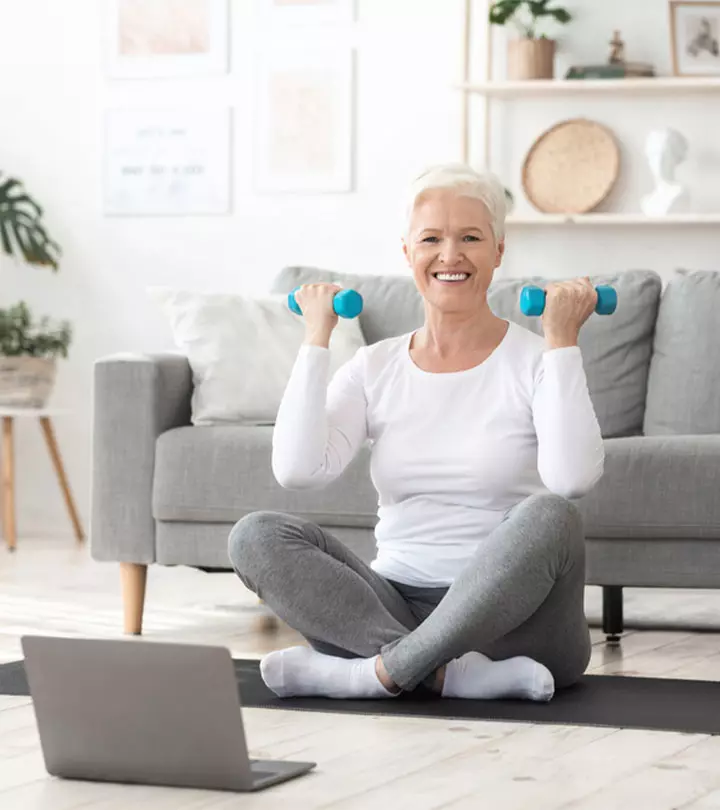


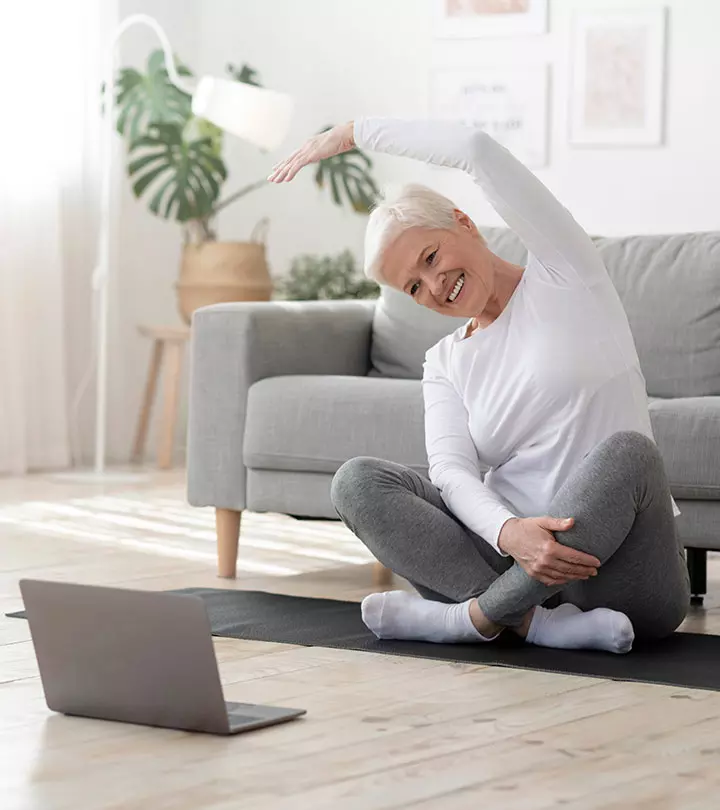
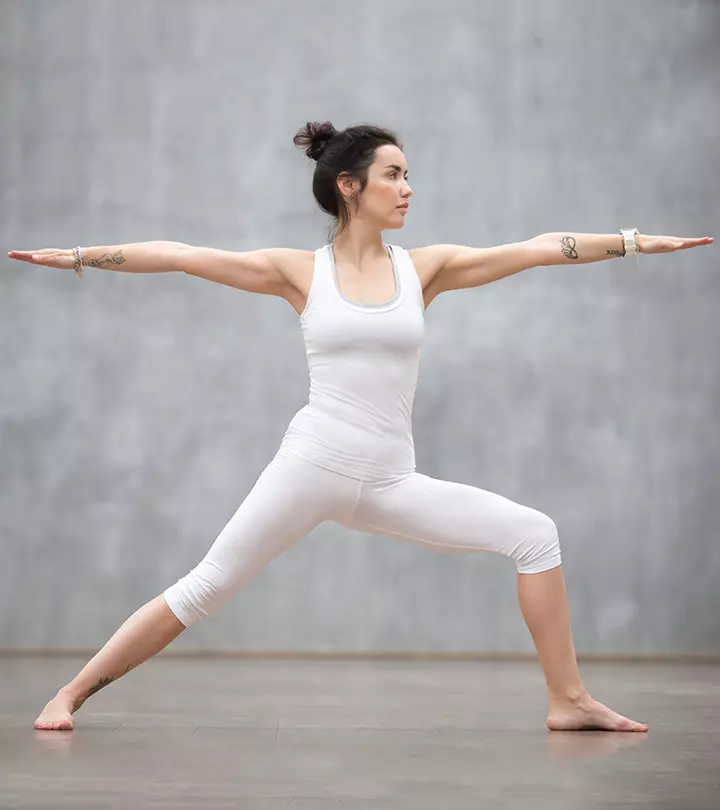

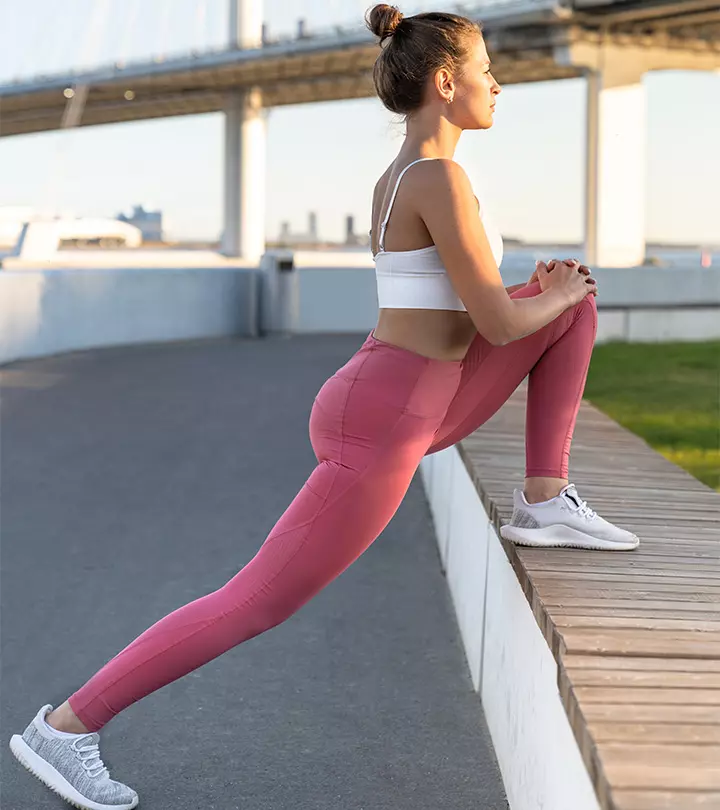
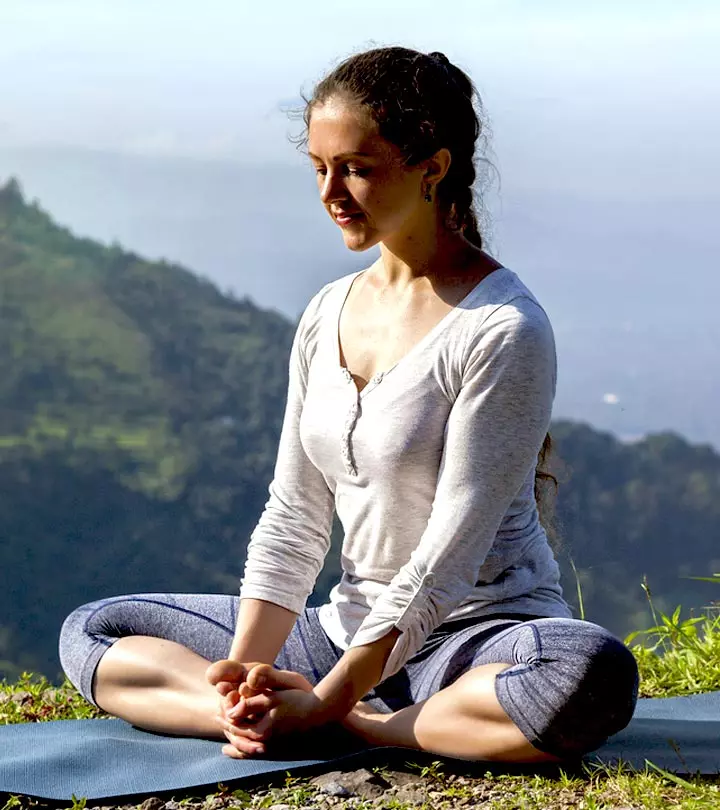




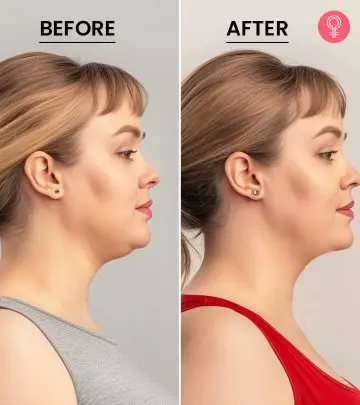
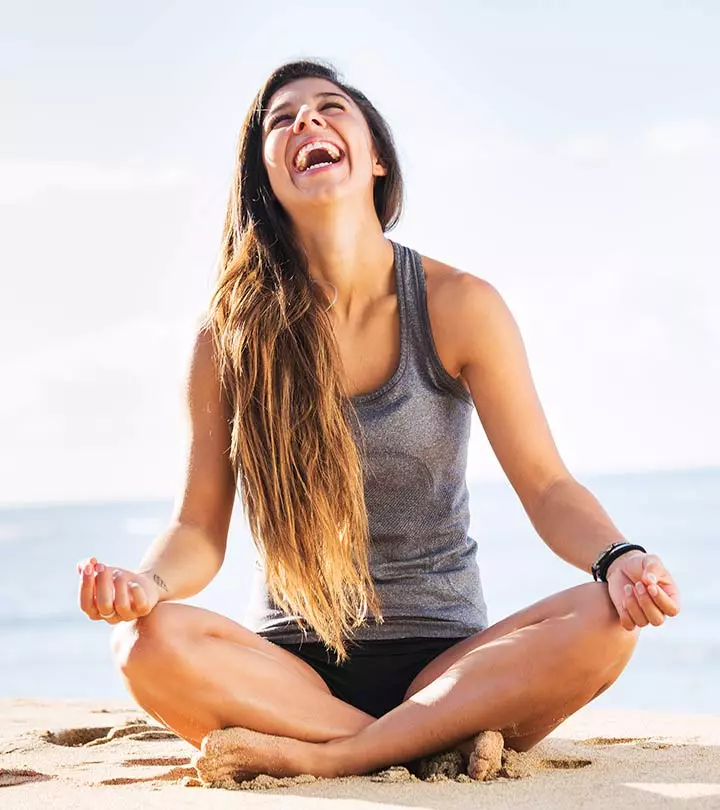

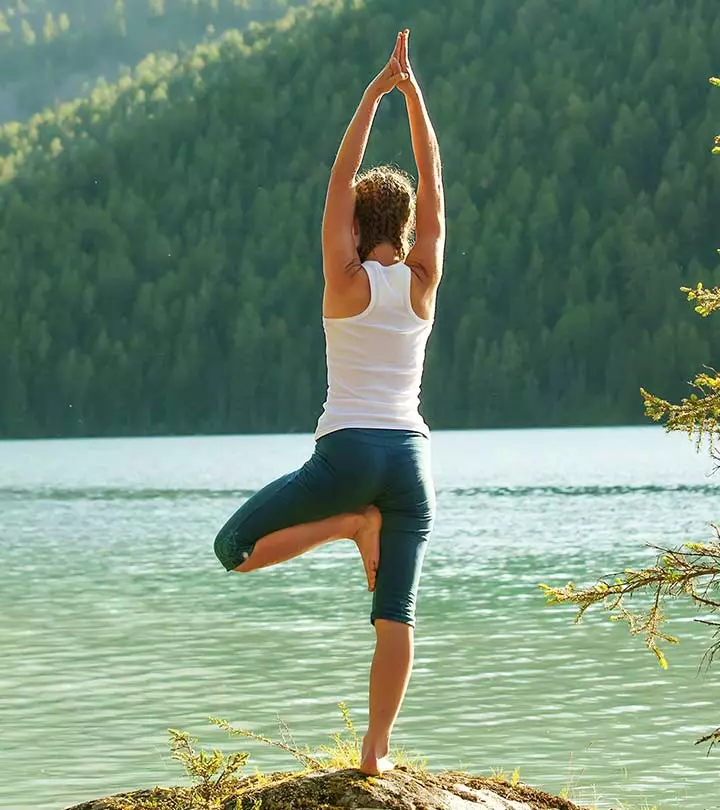

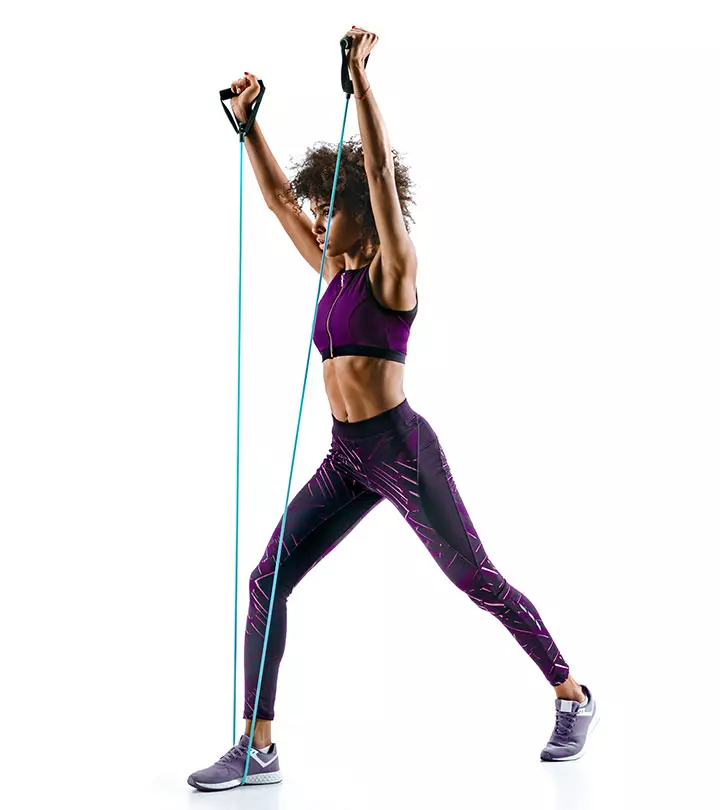

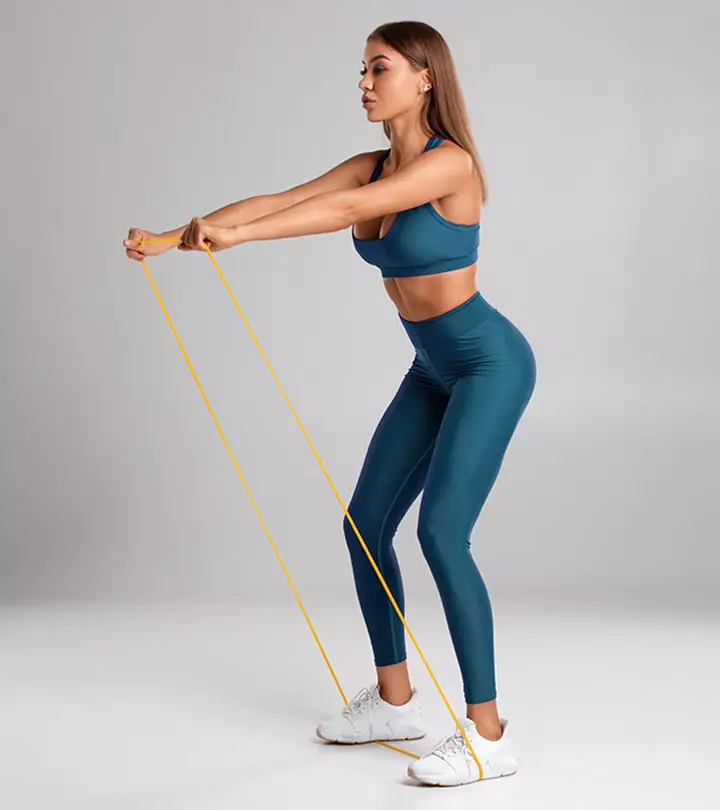
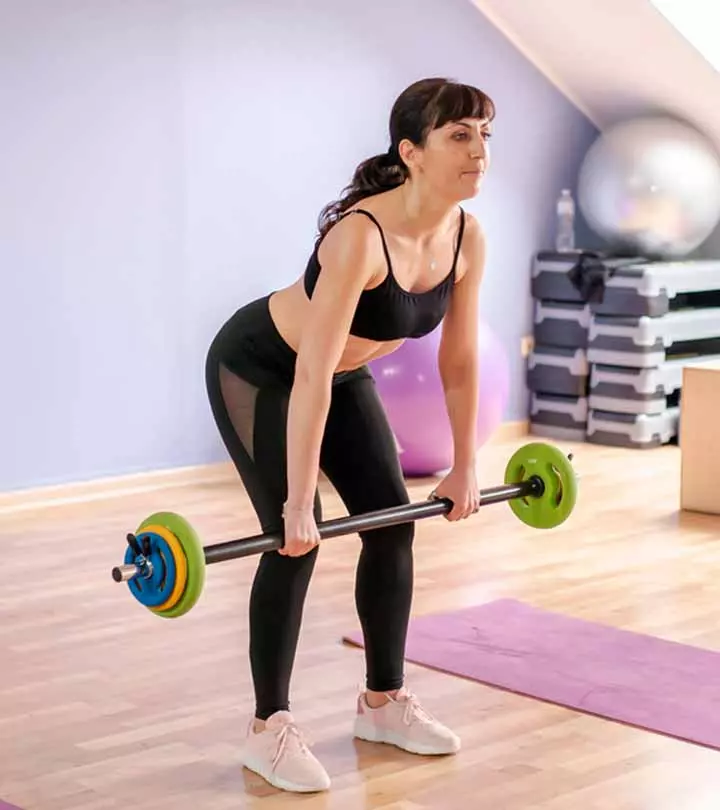
Community Experiences
Join the conversation and become a part of our empowering community! Share your stories, experiences, and insights to connect with other beauty, lifestyle, and health enthusiasts.